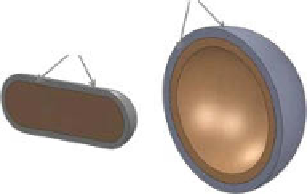Biomedical Engineering Reference
In-Depth Information
5.4.6
gold Nanoprisms
Recently, a novel class of plasmonic nanoparticle gold nanoprisms (AuNPr) has
emerged as signal amplifiers in msOT, and their applicability to visualize gastroin-
testinal cancer has been demonstrated [161]. Pegylated versions of AuNPrs were
successfully internalized by HT-29 gastrointestinal cancer cells
in vitro
. The particles
have been reported to feature good biocompatibility and a surface plasmon band cen-
tered at 830 nm, a suitable wavelength for OA imaging. Both
in vitro
and
in vivo
results showed that AuNPrs have the capacity to penetrate tumors and provide a high-
resolution signal amplifier for OA imaging.
5.4.7
silica-coated plasmonic Nanoparticles
several reviews have analyzed different aspects of synthesis of multifunctional plas-
monic nanostructures such as dispersibility in aqueous solutions, photolumines-
cence, and resistance to degradation [96, 103, 104, 121, 143, 145, 162, 163]. good
dispersibility of these nanoparticles is a key for biological applications and can be
improved by surface modification. Typically, organic coatings are present on the
nanoparticle surface from its wet synthesis, which include surfactants, citrate [164,
165], polymers [166], or starch [167]. However, nanoparticles coated with organics
may not be stable over time, and therefore, often, an extra inorganic surface coating
is sought [168]. silica (siO
2
) coating can be applied by wet chemistry on both gold
and silver nanoparticles [168-170] (fig. 5.19). The thickness and the homogeneity of
the surface coating can be well controlled. Importantly, silica coating is rather porous
allowing the transport of ions [169, 170]. Particularly, gold core silica nanoparticles
show promise for OA imaging [171, 172].
several groups have successfully demonstrated silica covering of gold nanorods
for prevention of destruction during high-fluence laser illumination and for enhanced
OA response [172-176]. Thermal equilibration between electrons and the lattice in
electron-phonon coupling was thought to cause temperatures in excess of melting,
causing structural rearrangements [177]. The groups of Li [178] and emelianov
[172] have shown that the threshold for photon-induced reshaping can be raised by
encapsulating gold nanorods in an amorphous silica matrix. Both groups use a sin-
gle-step method where an alkoxide-based silica precursor, tetraethyl orthosilicate
Silica
Silica
HGNS
GNR
figure 5.19
schematic of gold nanorods and hollow gold nanoshells with silica cover.

Search WWH ::

Custom Search